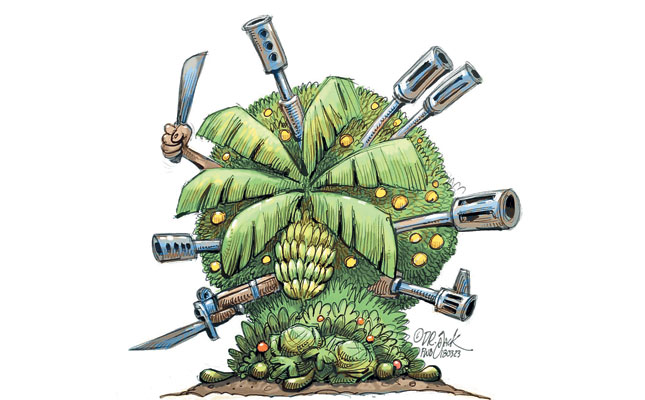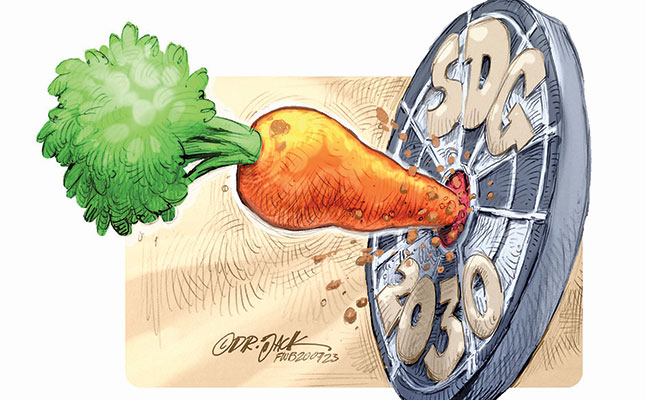
Photo: Dr Jack
The notion that food scarcity increases the likelihood of conflict is not a recent one, although it has received increased attention over the past four decades.
A growing number of studies draw links between civil war and food scarcity due to environmental conditions such as drought. By and large, the emphasis is on food scarcities, namely that rising temperature and droughts reduce the amount of food resources available locally, which in turn forces actors to obtain access to food via violent means.
READ How important is the informal sector in urban food security?
One study, for example, shows that rebels benefit from higher food crop prices due to scarcity; these allow them to expand territorial control and even establish a local monopoly on violence.
But despite this and other important evidence, an impressive body of research draws a link between the abundance of natural resources and conflict.
Food is not only a renewable natural resource, it’s crucial to maintaining the daily life and activities of a group, be it a rebel contingent or a rural community. As a result, areas with more food resources are more valued and so attract more conflict.
The agricultural land can be owned by smallholders who grow food for personal consumption only, or by larger producers who grow food for trade, both internationally and domestically.
When discussing conflict over food sources, it’s important to distinguish between four different categories:
- Official military and auxiliary state forces that do not receive (regular) support from the state. This category includes most official state forces in Africa. Studies show that militia groups such as the Janjaweed in Sudan are likely to be sent to prey upon the local population, sometimes with logistical support being intentionally withdrawn from them to push them toward violent appropriations of food resources. Such groups are thus likely not only to initiate conflict in areas with abundant food resources, but gravitate toward these areas during times of war.
- Rebels operating against the government. These groups might attack areas with more food to support themselves, challenge state strongholds, or exploit local food resources for profit. For example, the Islamic State (ISIS) in Syria and Iraq fought to establish and maintain control over agricultural areas due to the group’s reliance on agricultural income.
- Forces representing agriculturists in rural regions. In many countries, farmers are less likely to be defended by the state due to the costs involved in supporting a strong military presence in a trouble spot. With property rights rarely enforced, many communities establish self-defence militias. These can be used not only to defend against potential raids, but attack neighbouring communities to establish control over more arable land and food resources.
- Forces representing pastoral communities.
These raid other pastoralists to replenish their herds. They also attack agricultural communities to steal livestock and food crops, which, due to their nomadic lifestyle and the arid regions where they live, they generally cannot grow themselves.
Pastoralists have been at the heart of many previous studies connecting food resources to conflict, with some researchers associating increases in precipitation with higher frequencies of raids, and others showing the opposite.
Ongoing food insecurity
It’s important to note that these categories might overlap significantly. For example, in regions without developed infrastructure and where appropriating food is less possible, both government and rebel troops might be forced to move into areas that offer access to
food in order to support their operations.
READ SA needs stricter safety policies for imported food products
Furthermore, while agricultural and pastoral communities can produce food for personal
consumption, they are often under threat of food insecurity. Disease or drought can rapidly
kill crops or decimate herds, placing these communities at the immediate risk of starvation.
Without the ability to purchase drought-resistant seeds or livestock, and without
government or international support, which in many cases cannot arrive in time or be received by those who need it, the only alternative may be to obtain food through using violence.
Conflict can also be spurred by population growth, which increases the pressure to secure
more resources simply to maintain current sustenance levels. To increase overall resilience,
communities have to obtain access to enough food resources during periods of plenty.
Finally, it’s important to emphasise that while conflict frequency might increase with higher
productivity, food is not necessarily the cause.
In a full-scale civil war particularly, troops gravitate to areas with more food resources to
secure food or prevent these resources from being consumed by the enemy. That is, locations with more food resources might attract and sustain a large portion of ongoing violence.
Food insecurity can also be used as a weapon of conflict in itself, as adversaries
deliberately starve opponents into submission by destroying crops, livestock and markets, and divert food relief from intended beneficiaries to armed groups and their supporters.
Further study is required
All of this, of course, does not mean that prolonged heatwaves or lower yields do not affect conflict. It simply means that, however valid, scarcity based approaches are insufficient for explaining localised conflict over food resources.
READ Global hunger: the price we pay for food
The relationships between climatic variability, food and violence are more complex than
generally assumed, and warrant further study.
Hunger and conflict usually go hand in hand, but using data on food productivity and the nature and context of the violence can increase our understanding of how to prevent or
mitigate conflict and its consequences.
The views expressed in our weekly opinion piece do not necessarily reflect those of Farmer’s Weekly.
Ore Koren is a US Foreign Policy and International Fellow at the Dickey College for International Understanding, Dartmouth College, New Hampshire. This article is an abstract from ‘Food Abundance and Violent Conflict in Africa’, published in the American Journal of Agricultural Economics (February, 2018). To read the full study, go academic.oup.com.










